Luminescent lighting of T4, T5 and T8
Technical characteristics, used ballasts, spectral combinations

- Tips for choosing lighting
- The picture shows how much the light intensity decreases at the bottom of the aqua depending on the depth
- Picture on the penetration of light into the thickness of water
- Osram color catalog in .PDF format
- Spectral characteristics of LL from the manufacturer Osram
- Indices of color marking ЛЛ
- LL compatibility and technical specifications for electronic ballast for size T5 from Osram
- The main manufacturers of non-specialized lamps, linear dimensions
- The main characteristics of LL size T4 and T5 from the manufacturer Navicator
- Possible malfunctions of the light bulb
- Characteristics of the light bulbs from DENERLLE
- Characteristics of lamps from Hagen
- Catalogs for lumlams 2007 and 2009/2010 from Sylvania
- Examples of aquariums and the arrangement of lighting lamps
Any, even the most primitively organized aquarium, should be considered as an artificial microbiocenosis created by the aquarist himself. Consequently, the aquarist himself is able to manage the energy flows entering the aquarium (light, temperature, water flow, feeding, etc.) to some extent. The task of the aquarist is to balance these flows. You can use the formula:
Proposed energy -> accumulated energy -> allocated energy
It is important to understand that the processes of dissimilation should not prevail over the synthesis processes in both individual species and the species community of the aquarium as a whole. The primary producers in the trophic chain of the aquarium are chemo- and photosynthesizing bacteria, inferior algae and green plants.
So how do you properly illuminate your aquarium? Unfortunately, I still have never seen on sale ready-made aquariums, in which the lighting would have been cleverly thought out. As a rule, they either do not have enough lamps, or worse, the length of the lamps does not correspond to the length of the aquarium. This means that the necessary amount of light energy for further transformation of the plant community will not receive. With an aquarium height of 40-50 cm, the luminous flux should be within 30-50 lumens per liter. And no calculations in watts! Luminescent tubes of the same length have different luminous efficiencies:
- LB-40 lamp - 2800 lm
- Hagen Sun Glo - 3100 lm
- Hagen AquaGlo - 960 lm
- Sylvania DaylightStar - 3250 lm
A sure sign of correct lighting in the aquarium is when, 3-4 hours after switching on the light, oxygen begins to separate from the intercellular space of plant tissues in the form of optically visible bubbles. By the way, the big misconception is the opinion that the isolation of atomic oxygen is the beginning of photosynthesis. For this it is sufficient that one quantum of light per molecule of chlorophyll. In this case, oxygen, split off from the water molecule during photolysis, diffuses into the water as a by-product. But first, in the first hours after turning on the lighting, the oxygen released dissolves in the water. And only then, when the intercellular liquid is oversaturated, it begins to be released apparently for the eyes. Naturally, this release of oxygen under normal illumination is possible only if there is a sufficient amount of CO2, an optimal temperature and a balanced micro and macro nutriment. Thus, when calculating lighting, the first thing to do is to calculate the necessary luminous flux in your aquarium.
Now let's talk about the spectral composition of the aquarium lighting. In the light culture of plants, much attention is paid to the spectral composition of the proposed light. The spectral composition affects all processes of vital activity of plant organisms, growth, development, photoperiodism, movement, the formation of pigments, the coloring of plants, etc. One can, as long as you like, talk about the influence of the quality of light in the process of photosynthesis on various biochemical reactions and the orientation of photosynthesis itself, That plants need more orange-red long-wave radiation than blue-violet short-wave radiation. Comparative studies of the intensity of photosynthesis in some plants under illumination below light saturation showed that the intensity of photosynthesis was maximum in red and minimal in the blue and green parts of the spectrum. At light saturation, the maximum photosynthetic rates for rays of different wavelengths were almost identical. When the illumination was aligned by the number of quanta absorbed, the photosynthetic curves for red, blue, and white were the same.
The advice of "advanced" aquarists on the use of only special phytolamps with the predominance of the red component in the spectrum is not entirely correct. Such advice only makes sense if there is a frank lack of coverage. In my aquariums I use combinations of Hagen SunGlo and AquaGlo and Sylvania GroLux, AquaStar and DaylightStar lamps. It is the GroLux lamp that has a clearly verified composition with maximum peaks in the blue-violet and orange-red parts of the FAI spectrum (physiologically active radiation). The combination of SunGlo with another and lamps similar in spectral data from GroLux also produced interesting results.
After differential spectrometry, it was found that the absorption bands of the pigment systems of most long-stemmed plants in my aquariums are close to the spectral curves of the GroLux lamp.
In general, gradually for myself, I came to the following conclusion: in a properly organized aquarium with plants, it is worthwhile to use two types of lamps: giving the maximum luminous flux, to reach the norm of 30-50 lm / l and phytolamp with a spectrum of maximum absorption of plant pigment systems. As the first, I prefer Hagen LifeGLO, SunGlo and Sylvania AquaStar, DaylightStar. Second lamps: Hagen AquaGlo and Sylvania GroLux. And here I phray for myself floraGlo - despite the good growth of plants under it, it fairly stimulates the development of algae.
In addition to brightness and spectrum, the third important parameter is the length of the light day. There is a fairly common belief that light inhibits the growth of plants. In fact, light restricts only the phase of cell stretching and accelerates their transition to differentiation. Many aquarists still think that plants grow only in the dark. This is not so, and that's why. The increase in the size of a multicellular plant is due solely to the growth of cells in the stretching phase. And that's just how light just inhibits cell stretching, but not completely. Mitoses of cells occur continuously and also continuously, albeit at different rates, the cell sizes increase.
In a decorative aquarium you need to find a compromise between the desire to observe your aquarium as much as possible and the right rhythm day and night in the life of plants. My aquariums are lit 10-12 hours a day, from 10 to 20-22 hours; The peak of oxygen saturation is 19-21 hours, about 13 mg / l. 100 percent oxygen saturation of water - about 5 hours after switching on the lighting. All in full accordance with the recommendations of Kaspar Horst.
Sufficient light day for most plants in aquariums - 8-10 hours, it is clearly visible on the closure of the apical points of long-stemmed plants.
 Technical characteristics of lighting
Technical characteristics of lighting
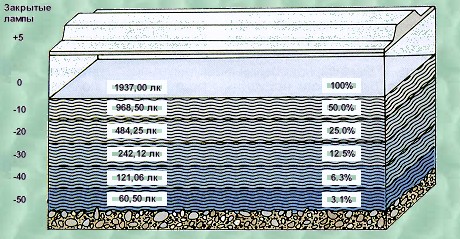
 Picture of the penetrability of light in the thickness of water:
Picture of the penetrability of light in the thickness of water:
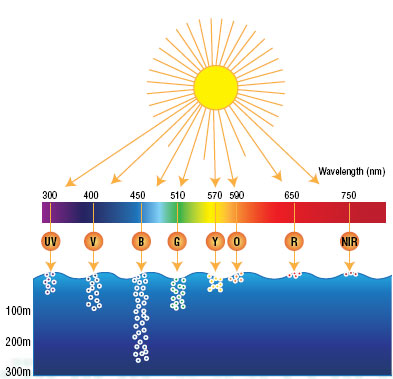
 The color catalog of Osram products in .PDF format:
The color catalog of Osram products in .PDF format:
 [
[  ] [
] [  ]
]
 Spectral characteristics of LL from the manufacturer Osram:
Spectral characteristics of LL from the manufacturer Osram:
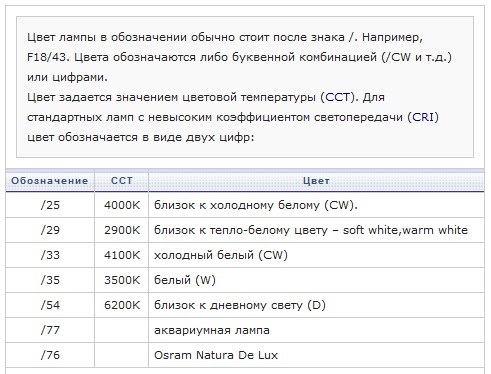
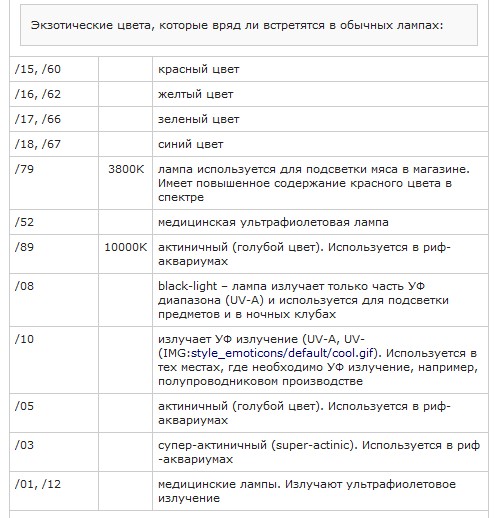
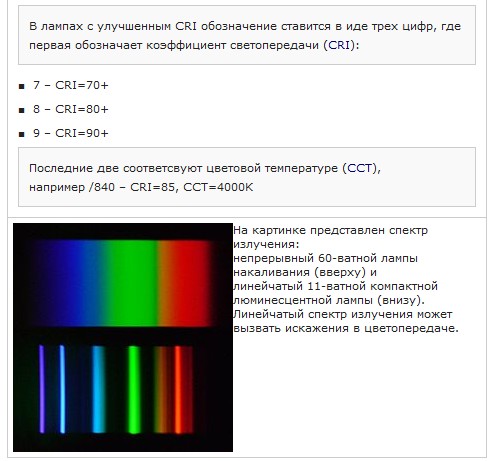
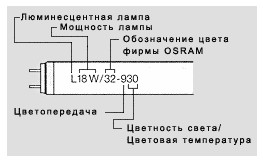
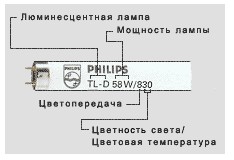
 LL compatibility and technical specifications for electronic ballast for size T5 from Osram:
LL compatibility and technical specifications for electronic ballast for size T5 from Osram:



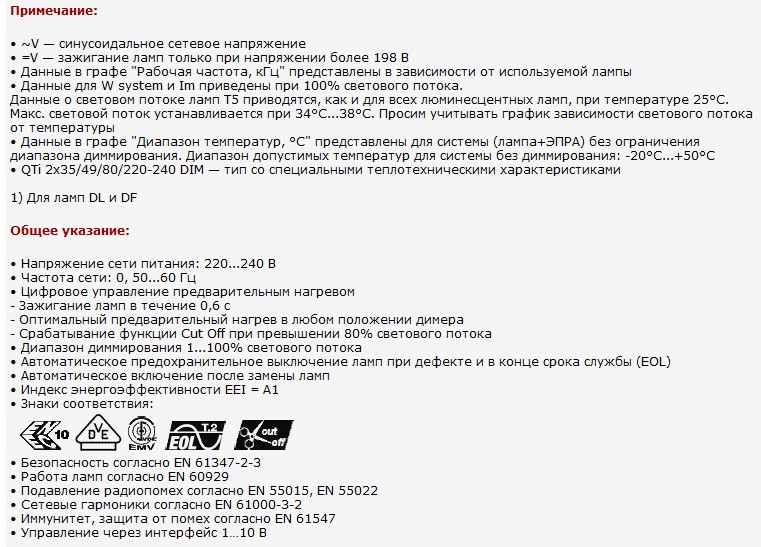
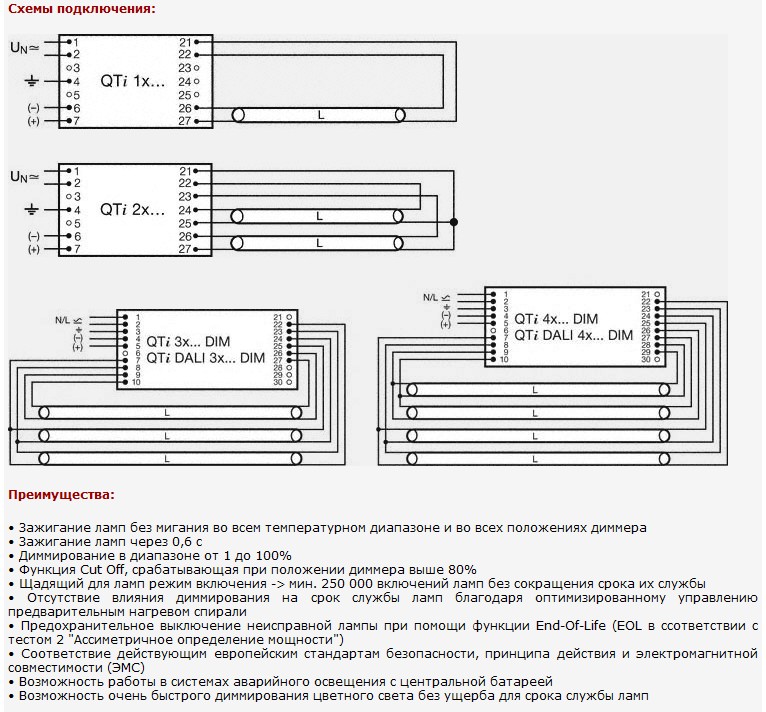

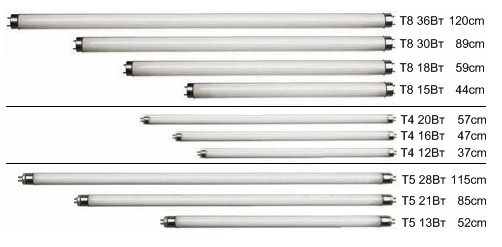
 The main characteristics of LL size T4 and T5 from the manufacturer Navicator:
The main characteristics of LL size T4 and T5 from the manufacturer Navicator:
 Possible malfunctions of the light bulb:
Possible malfunctions of the light bulb:


 Characteristics of the light bulb from DENERLLE:
Characteristics of the light bulb from DENERLLE:





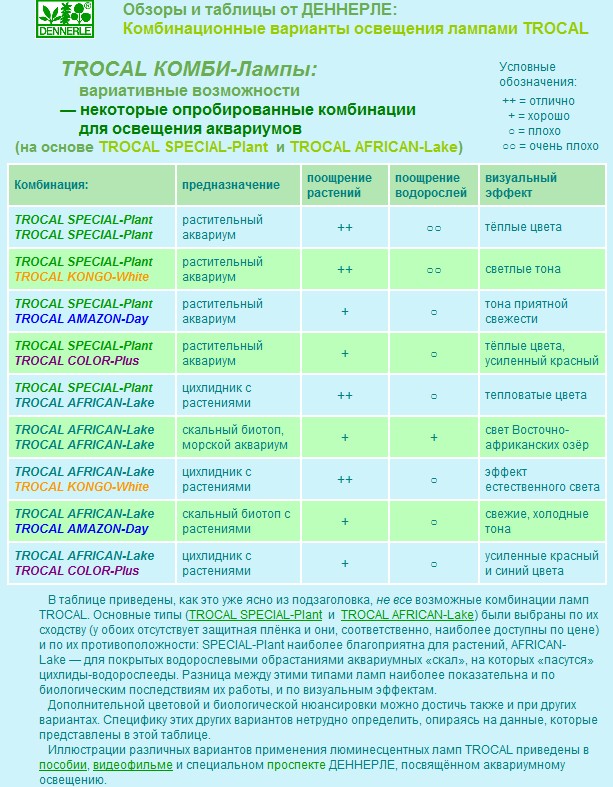
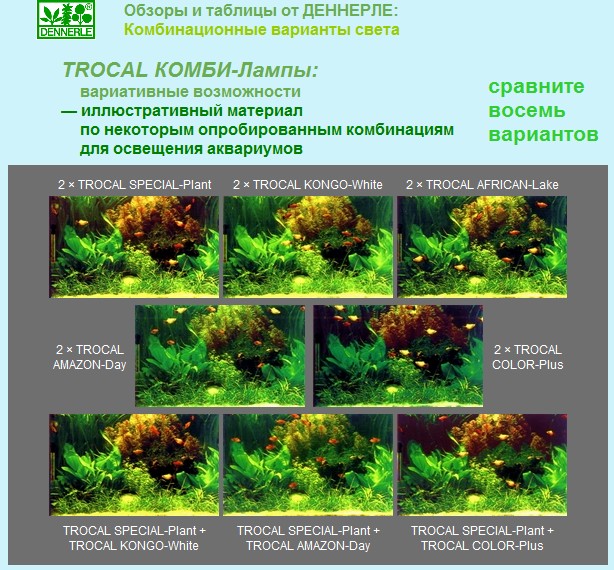
 Characteristics of lamps from Hagen:
Characteristics of lamps from Hagen:

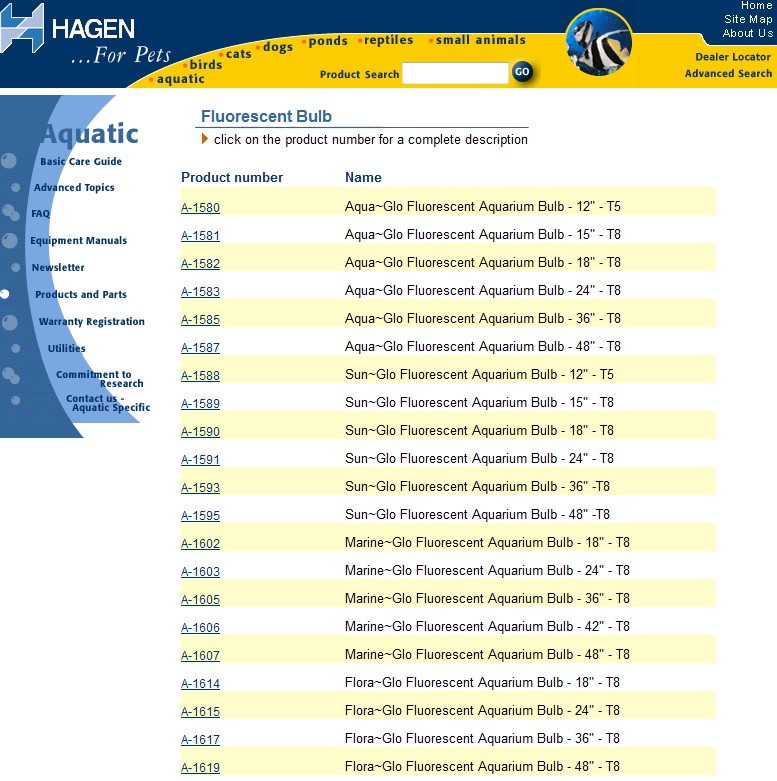
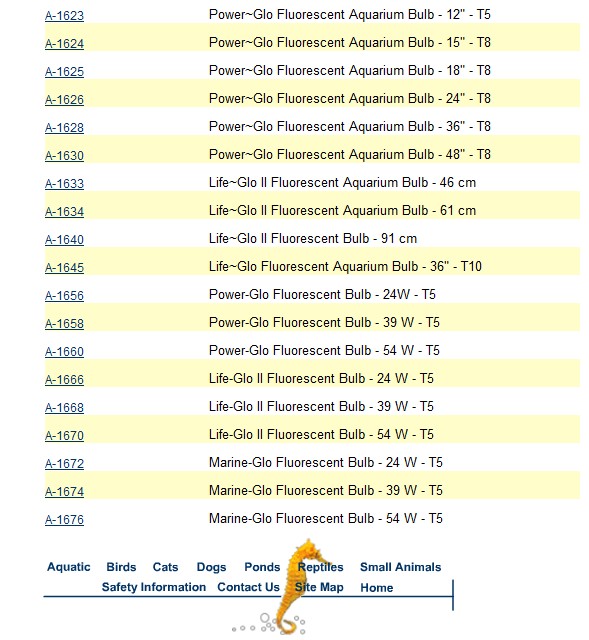
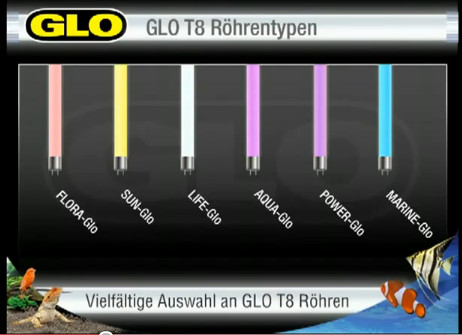

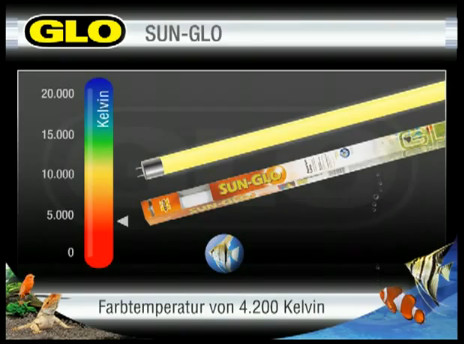
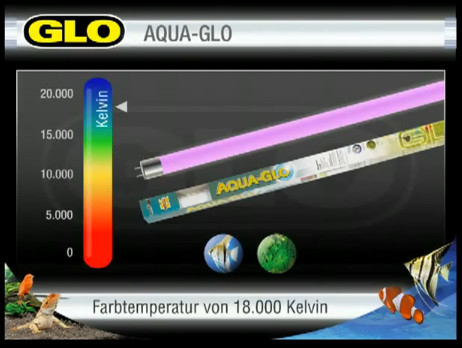
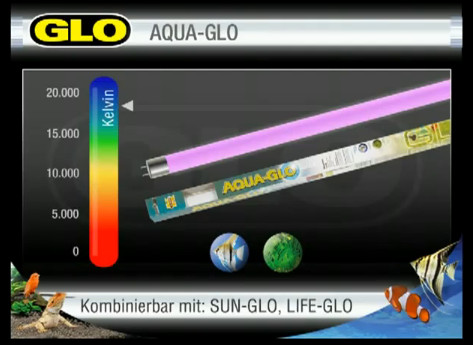
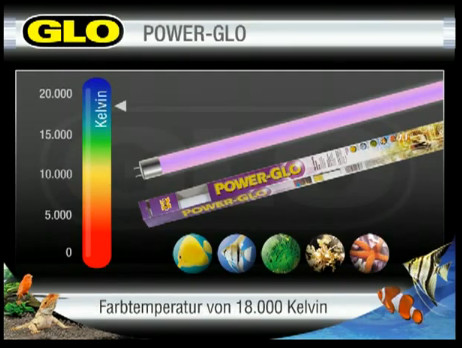
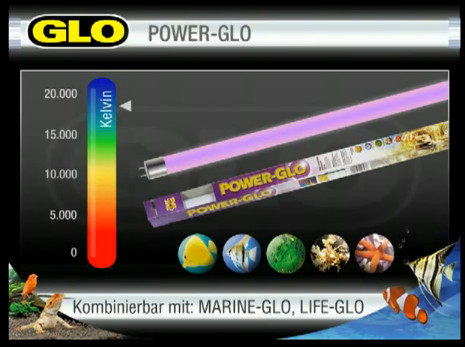
 Photo of aquariums and the arrangement of lighting lamps:
Photo of aquariums and the arrangement of lighting lamps:
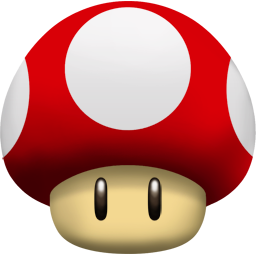








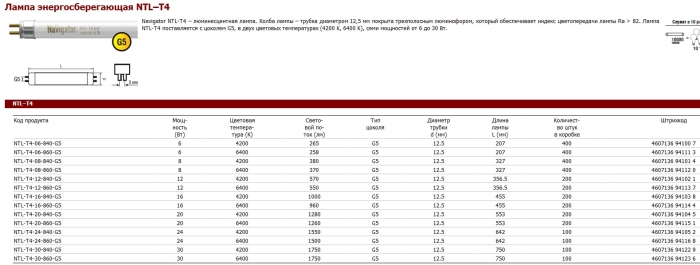















































































Comments
When commenting on, remember that the content and tone of your message can hurt the feelings of real people, show respect and tolerance to your interlocutors even if you do not share their opinion, your behavior in the conditions of freedom of expression and anonymity provided by the Internet, changes Not only virtual, but also the real world. All comments are hidden from the index, spam is controlled.